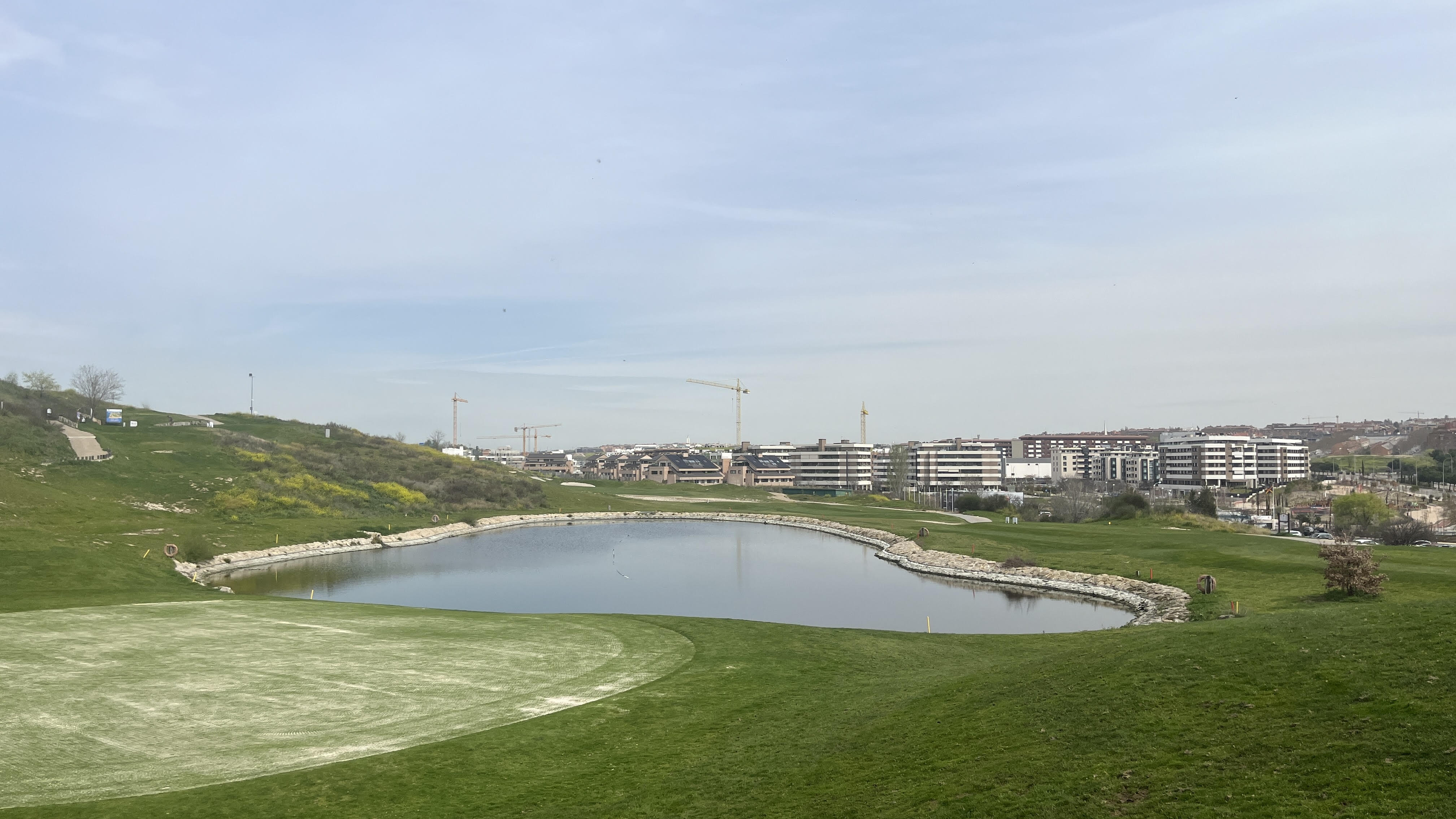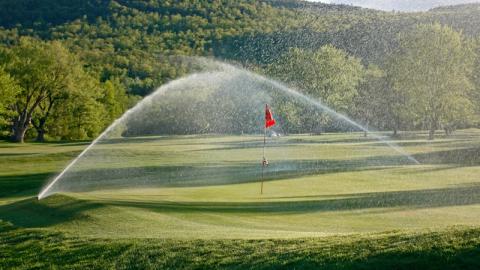The National Golf Centre (Spain) is a showpiece course created in the early 2,000s by the Royal Spanish Golf Federation in the municipality of Madrid to promote and facilitate the learning and practising of golf. Situated at less than fifteen minutes from the city centre, it has metro and bus services to hand, making its accessibility one of its virtues. Covering an area of 62 hectares, the 18-hole courses are designed to host the most prestigious international tournaments and also acts as a training facility for the national teams and the national school at the Joaquín Blume Residence. The course is open to the public and it also has a golfing school.

I travelled to the golf course with Gonzalo Valera from the company Hunter and we were met by David Gomez, director of the green section of Spain’s Royal Golf Federation, and Luis Lopez, the green keeper of the National Golf Course. Firstly, we made our way to their office.
Being at the head of a team of 5 to 8 people, depending on the season, David Gomez has many tasks to fulfil: apart from maintaining the public golf course and the private golf course, he is also responsible for the environmental aspect of the course with the assistance of the Spanish Greenkeepers’ Association. Furthermore, he and his team also share their expertise by acting as consultants for the 36 other prestigious golf courses in Spain. They assist the greenkeepers of these different golf clubs in the management of their golf courses, particularly the organisation of important competitions.
Over the last few years, the National Golf course has undergone modernisation work. The aim is to reduce the consumption of water, pesticides and energy to a minimum. Saving water has become particularly important in Spain, a country that has been increasingly affected by recurring droughts.
“The implementation of sustainable strategies for the conservation of natural resources and the environment, always focused on guaranteeing the enjoyment and satisfaction of the players who use our facilities every day, formed the basis of the project aimed at improving the efficiency and optimisation of the reclaimed water by reducing the areas irrigated between the tees and fairways”, explains David Gomez. The aim was to use 42% less water. Furthermore, over the last 7 years, the golf course has been entirely irrigated with recycled wastewater from the city of Madrid. The optimisation of the irrigation system and the use of recycled wastewater should enable the course managers to achieve this objective.
Moreover, the training course has been resurfaced with artificial turf, transforming this training area, which now has five greens and driving ranges at different distances. In total, 7,000 square metres have been resurfaced with artificial turf, which is much more effective, long-lasting and environmentally friendly, thus reducing the consumption of the reclaimed water.
A new central control irrigation system and 450 sprinklers relocated
Luis Lopez explained: “Four years ago, the satellite control was not working, so everything had to be irrigated manually”. And he added: “Furthermore, we were always having broken sprinklers and the irrigation cycle had to be repeated; we ended up irrigating twice a day”.
He, therefore, took the decision to replace the old system with Hunter’s central control system and remote-control unit. The instructions are sent from the computer via the controller, which is located in the office, on the wall. Communication signals between the controller and the sprinklers are sent by radio.
As well as benefiting from a brand-new centralised management system, the irrigation system has also been streamlined: they have not replaced the sprinklers because of budgetary constraints, but they have moved some of the Rain Bird sprinklers from the common areas, which will no longer be irrigated, to the fairways. And on the course itself, the sprinklers have been repositioned in a triangular pattern for more efficient irrigation. "The 18-hole course now has only 700 sprinklers, compared with 1,600 previously," explains David Gomez.
The common areas are going to dry out this summer, but the end result is a golf course of great aesthetic beauty, which, in practice, will result in a perfect contrast between the fairway and the rough, which will also make it easier to play for the players when they miss the fairway.
I then asked Mr. Lopez about the way he manages irrigation according to the seasons. He replied: “We do not irrigate between November and March, but we irrigate every day in the summer and during this period 80% of our time is spent on irrigation”.
The golf course is irrigated entirely with wastewater from the city of Madrid
The four of us then travelled to the golf course in two golf buggies, and we headed for holes 16, 17 and 18. I was stunned by the breathtaking view of the city of Madrid and its surrounding area. This is a truly urban golf course. We then entered the service room, which houses a Grundfos pumping station, a screen-type filter system and a water meter.
David Gomez explained: “There is a second pumping station on the golf course. In the past, one was used to irrigate the fairways using inferior quality ground water and the other one used to irrigate the tees and the greens with drinking water».
And he added: « nowadays, the whole golf course is irrigated with treated recycled water, which is of excellent quality”. The same recycled water is therefore kept in four reservoirs located on the golf course, and it is then channelled into two pumping stations for the irrigation of the whole golf course.
In the service room, there is also a fertilisation device, which was previously used to restore the pH of the water but this is no longer necessary because the pH of the recycled water is quite satisfactory.

We left the service room and head for the reservoir, located just above this room. David Gomez continues: "The recycled water is stored in the lake and flows down to the pumping station by gravity”. The course has four reservoirs similar to this one. For the record, 70% of Spanish golf courses use recycled wastewater for their irrigation and Spain has a total of 420 golf courses.
We climbed back into the buggy and headed for hole 9 on the other side of the golf course. Another reservoir and the second service room are located in this part of the course. Down below, we can see a large driving range, on two levels. David Gomez adds: "2,600 people come here to practise, and 50,000 golf balls are driven every year”. The national golf course is also home to a golf school and 14 instructors are available for all students, with the aim of making golf accessible to as many people as possible.
I then asked David Gomez about the water savings achieved with this new installation. "Since we have made quite a few changes – we have removed some sprinklers, relocated some of the other ones, installed a new central control system and replaced some of the grass with synthetic turf - it's difficult to know where the water savings have been made. What I can say, however, is that, in spite of two particularly scorching summers in 2022 and 2023, the grass areas were in much better condition than before”.
The changes recently made to the irrigation system are part of an overall approach adopted by Golf Nacional, complying with the commitment to develop new methods of managing and operating a golf course, which has made Golf Nacional an international benchmark for sports facility management.

